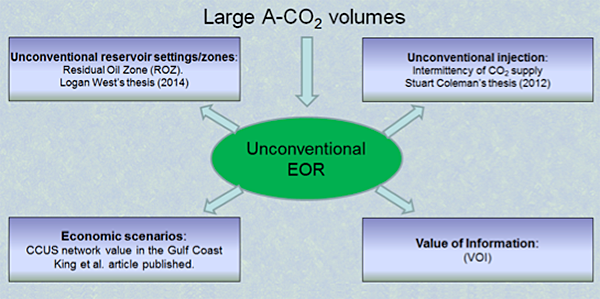Research Theme 2
Unconventional EOR

Research themes under Unconventional EOR
Theme 2: Unconventional EOR [PDF]
The research topics under the Unconventional Enhanced Oil Recovery (EOR) theme investigate the large volumes of CO2 that would result from the commercial implementation of Carbon Capture, Utilization and Storage (CCUS), and how those volumes would not only impose technical and economic changes to conventional EOR operations, but also extend the breadth of reservoir settings to include those currently excluded from development.
Accomplishments
- Performed a value of information (VOI) analysis in a specific CCS setting by defining some prior scenarios with different probabilities and outcomes on the basis of the current knowledge of a reservoir, contractual requirements, and regulatory constraints.
- Completed a study on reservoir performance and impact from using large-volume, intermittent, anthropogenic CO2 captured from a power plant for EOR as compared to a steady but limited volume stream of CO2 from a natural or gas-plant source
- Compared several bounding cases for understanding the economic viability of capturing large quantities of anthropogenic CO2 from coal-fired power generators within the Electric Reliability Council of Texas (ERCOT) electric grid and using it for pure CO2 EOR in the onshore coastal region of Texas along the Gulf of Mexico.
- Performed sever novel types of analysis to assess the genesis and potential distribution of residual oil zones (ROZs) in the Permian Basin was performed to assess qualitatively the potential for a ROZ resource and determine implications for related CO2 storage.
Key Findings
- The accuracy of the information-gathering activity depends on the number of wells logged or cored, with 66 wells being optimal corresponding to a net VOI of $2.8 million.
- Provided that the specified volume of anthropogenic CO2, agreed upon by the operator and the utility company, is supplied for a given period, the rate and frequency at which that volume of CO2 is delivered to the EOR field should not impact overall oil production.
- The mobility ratio is critical to determining CO2 breakthrough and oil displacement efficiency. The longer CO2 breakthrough can be delayed, the less CO2 is recycled, thereby improving storage efficiency.
- Scenarios for a CCUS Network in the Gulf Coast show a system-wide net present value (NPV) range from -$23 billion (scenario 4: fast EOR development with CO2 emissions penalty) to -$1.0 billion (scenario 1, slow EOR development with CO2 sales price). These two scenarios sequester large quantities of CO2 of 1,450 Mt CO2 and 240 Mt CO2, respectively, over 20 years.
- Geomorphic , structural, and hydrodynamic data and oil compositional analysis support other indicators of widespread potential for ROZ presence and carbon capture use and storage (CCUS) opportunities in the Permian Basin.
Unconventional EOR Subthemes
- Topic 1—Value of Information [PDF]
This study estimated the maximum amount that a decision maker should be willing to pay for information-gathering activities. (Puerta Ortega, C. A., 2012, A value of information analysis of permeability data in a carbon, capture and storage project: The University of Texas at Austin, Master's thesis, LINK.) - Topic 2—Impact of CO2 Source Intermittency [PDF]
The goal of this work was to understand the impact on value for EOR and revenue of CO2 sourced from power and industrial facilities. (Coleman, S. H., 2012, The reservoir performance and impact from using large-volume, intermittent, anthropogenic CO2 for enhanced oil recovery: The University of Texas at Austin, Master's thesis, LINK.) - Topic 3—CCUS Network Value in the Gulf Coast [PDF]
This project developed a network cash flow scenario, which was analyzed to determine the value to the Gulf Coast for the CCS industry and possible contract structures between power/industrial capture facilities and EOR/sequestration operators. (King, C. W., Gülen, Gürcan, Cohen, S. M., and Nuñez-Lopez, Vanessa, 2013, The system-wide economics of a carbon dioxide capture, utilization, and storage network: Texas Gulf Coast w/ pure CO2–EOR flood: Environmental Research Letters, 8, 034030.) - Topic 4—Permian Basin ROZ Analysis [PDF]
An independent analysis of genesis and potential distribution of ROZs in the Permian Basin conducted to qualitatively assess the potential ROZ resource and implications for related CO2 storage. (West, L., 2014, Regional analysis of residual oil zone potential in the Permian Basin: The University of Texas at Austin, Master's thesis, LINK)
Personnel
- Vanessa Nunez
- Carlos Puerta
- Stuart Coleman
- Carey King
- Logan West



